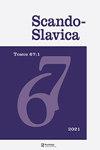Between Parody and Pastiche: The Posthuman Biomechanics of Bulgakov’s Novellas
IF 0.2
0 HUMANITIES, MULTIDISCIPLINARY
引用次数: 0
Abstract
ABSTRACT The article examines the birth of biomechanics in Soviet scientific discourses and how it was absorbed by the theater and literature of the day, in a reading of Michail Bulgakov’s three novellas “D′javoljada” (1924), “Rokovye jajca” (1924) and “Sobač′e serdce” (1925), interpreting them as both products of and critical reactions to the transformational trends in early Soviet ideology. While artists and theorists like Aleksej Gastev worked to ensure the creation of the New Man by reshaping the human animal into an industrious mechanical man of steel, Bulgakov actively opposed such ideas. In his fiction, he exhibits a dialogical and contentious relationship to biomechanics. This reading argues that the novellas are paradoxically dependent on notions of mechanization and hybridity, aligning them with features of posthumanism, at the expense of Bulgakov’s satirical attacks on Vsevolod Mejerchol′d and his theatrical biomechanics. The noisy soundscapes, metal tropes and mechanical motifs that shape the novellas, at times distract from Bulgakov’s parodic affect and nurture instances of pastiche, making his early short prose indebted to none other than his avant-garde adversaries of the 1920s. 1 1 Acknowledgements: The current article is a revised version of a chapter from my MA thesis, Refiguring the New Man: Animality and Machinery in Three of Bulgakov’s Novellas. I would like to thank Professor Ingunn Lunde for her insights and supervision, Professor Eric Naiman for his constructive criticisms, and the Davis Center at Harvard University for hosting me as I edited this material into a publishable article.在模仿与模仿之间:布尔加科夫中篇小说的后人类生物力学
摘要本文通过阅读迈克尔·布尔加科夫的三部中篇小说《D’javoljada》(1924年)、《Rokovye jajca》(1924)和《Sobače serdce》(1925年),探讨了生物力学在苏联科学话语中的诞生,以及它是如何被当时的戏剧和文学所吸收的,将它们解释为苏联早期意识形态转型趋势的产物和批判性反应。虽然像Aleksej Gastev这样的艺术家和理论家努力通过将人类动物重塑为勤劳的钢铁机械人来确保新人类的创造,但布尔加科夫积极反对这种想法。在他的小说中,他展示了一种与生物力学的对话性和争议性关系。这篇文章认为,这些中篇小说矛盾地依赖于机械化和混合性的概念,使它们与后人道主义的特征相一致,而牺牲了布尔加科夫对Vsevolod Mejerchol的讽刺攻击和他的戏剧生物力学。塑造中篇小说的嘈杂声景、金属比喻和机械主题有时会分散布尔加科夫的戏仿影响,并培养出模仿的例子,这使得他早期的短篇散文归功于20世纪20年代的先锋派对手。11致谢:本文是我的文学硕士论文《重塑新人:布尔加科夫三部小说中的动物与机械》中一章的修订版。我要感谢Ingunn Lunde教授的见解和监督,感谢Eric Naiman教授的建设性批评,感谢哈佛大学戴维斯中心在我将这些材料编辑成可发表文章时接待我。
本文章由计算机程序翻译,如有差异,请以英文原文为准。
求助全文
约1分钟内获得全文
求助全文

 求助内容:
求助内容: 应助结果提醒方式:
应助结果提醒方式:


